
The Reality Dysfunction
Book Description
In a universe where the dead are rising and chaos looms, humanity's struggle for survival ignites a fierce battle between the living and the unimaginable. As factions clash and secrets unravel, a diverse cast of characters finds their destinies entwined in a desperate fight for hope. The struggle for reality itself unfolds as alliances form and betrayals surface, forcing everyone to confront the darkest corners of their own souls. With time running out and the stakes higher than ever, who can emerge unscathed when the fabric of existence teeters on the brink? Will anyone survive the ultimate confrontation?
Quick Book Summary
"The Reality Dysfunction" by Peter F. Hamilton is a sprawling space opera set in a far future where humanity has colonized dozens of star systems. The story follows myriad characters, including starship captains, religious zealots, political leaders, and criminals, whose fates interconnect as a terrifying horror is unleashed on the universe. A mysterious event on the planet Lalonde triggers the return of the dead, who begin to possess the living and threaten the very fabric of reality. As news of this supernatural disaster spreads, various factions scramble to contain the threat, each with their own motives. Blending science fiction, horror, and social commentary, the novel explores the limits of technology, the fragility of society, and the enduring struggle between hope and despair.
Summary of Key Ideas
Table of Contents
The Collapse of Reality and Return of the Dead
Set in the 27th century, humanity commands a vast galactic empire, settling worlds with advanced biotechnology and interstellar transport. The divide between Edenist and Adamist civilizations has fostered both cooperation and rivalry, creating a tapestry of political ambitions and technological wonders. Hamilton’s universe is meticulously detailed, blending high-concept science with believable societies and complex, multi-faceted characters. These worlds teem with life, ambition, and secrets, each colony distinct and vibrant—a stage ripe for disaster to strike.
Factions and Political Intrigue in a Colonized Galaxy
The catalyst for chaos is the planet Lalonde, a remote colony where a horrifying phenomenon occurs: the dead begin to possess the living. The event spreads with infectious speed, threatening the sanity and survival of every human settlement. As the phenomenon escalates, supernatural terror clashes with the rationalism of Hamilton’s world, forcing a reevaluation of what is possible. The revelation that death is not the end, but a portal for lurking consciousnesses, subverts the foundations of science and faith alike.
Technological Wonders and Human Limitations
Multiple characters—Joshua Calvert, a daring starship captain; Syrinx, an Edenist pilot; Quinn Dexter, a fanatic with dark motives; and Al Capone, resurrected from history—find themselves on intersecting paths, each drawn deeper into the crisis. Their personal ambitions, fears, and alliances shape the unfolding conflict. As factional interests ignite and alliances shift, the threat transcends individual worlds, pulling the galaxy’s political and military powers toward an unprecedented confrontation.
Complex Characters Facing Existential Threats
Themes of power, faith, and the nature of evil drive characters’ flaws and strengths. Some seek salvation and unity, while others exploit chaos for personal gain. The moral dilemmas posed by the return of the dead—who deserve compassion or destruction—test humanity’s resolve and empathy. Characters must confront their own darkest impulses while navigating treachery and hope, forging uneasy partnerships as reality itself begins to unravel.
Moral Dilemmas and the Nature of Survival
As the struggle intensifies, the boundaries between science and the supernatural blur, highlighting both the potential and limitations of human ingenuity. The novel concludes with a galaxy on the brink, characters changed forever, and the conflict unresolved, setting the stage for further exploration of survival, redemption, and the question of what it truly means to be alive.
Download This Summary
Get a free PDF of this summary instantly — no email required.





